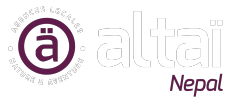Manaslu Circuit Trek
Itinerary
-
Day 1 Kathmandu
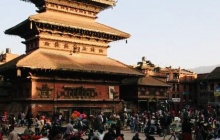 Welcome to Kathmandu! Your guide will greet you and escort you to your hotel. Depending on your arrival time, perhaps your trip leader can show you the old streets of Ason Tole and Indra Chowk and introduce you to the Nepalese way of living.
Welcome to Kathmandu! Your guide will greet you and escort you to your hotel. Depending on your arrival time, perhaps your trip leader can show you the old streets of Ason Tole and Indra Chowk and introduce you to the Nepalese way of living.
Accommodation: Hotel
Meals not included -
Day 2 Kathmandu - Gorkha - Barpak (1000m)
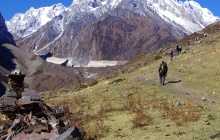 After breakfast, we head towards Barpak. We leave Kathmandu valley via the Thankot Mountain Pass (1400m) revealing our first stunning views of the Himilayas. We drive through green hills and the Dhorandi Khola valley up to Barpak. This is not the traditional starting point of the Manaslu circuit - Barpak enables us to enjoy a pleasantly different two days crossing authentic Gurung villages like Laprak and Singla and walking through the magnificent rice paddies which are scattered across the beautifully hilly landscape.
After breakfast, we head towards Barpak. We leave Kathmandu valley via the Thankot Mountain Pass (1400m) revealing our first stunning views of the Himilayas. We drive through green hills and the Dhorandi Khola valley up to Barpak. This is not the traditional starting point of the Manaslu circuit - Barpak enables us to enjoy a pleasantly different two days crossing authentic Gurung villages like Laprak and Singla and walking through the magnificent rice paddies which are scattered across the beautifully hilly landscape.
Transport: 7 hours drive
Accommodation: Lodge -
Day 3 Barpak - Laprak (2200m)
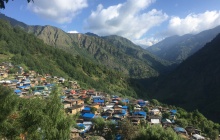 Through a calm forest trail, we reach the Pushu Danda at 3000 m altitude. Our effort is rewarded with superb views of Himal Buddha (6672 m) and the various peaks of Ganesh Himal (7100 m). Then, we descend to Laprak, another authentic Gurung village. We sneak in and out of stone houses receiving warm welcomes from our hosts.
Through a calm forest trail, we reach the Pushu Danda at 3000 m altitude. Our effort is rewarded with superb views of Himal Buddha (6672 m) and the various peaks of Ganesh Himal (7100 m). Then, we descend to Laprak, another authentic Gurung village. We sneak in and out of stone houses receiving warm welcomes from our hosts.
Hiking: 5 hours
Elevation: + 1100m / -700m
Accommodation: Lodge -
Day 4 Laprak - Singla - Khorla Bensi (970m)
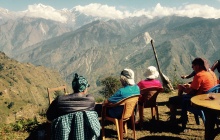 Todays' hike begins with a short descent to Machha Khola River, then it is a gradual ascent to Singla. Discover beautiful views of Laprak and Gumda villages which cling to the mountainsides and the terraced rice fields which stretch as far as the eye can see. From Singla, the imposing massif of Ganesh Himal once again captures our hearts. We walk down to Khorla Bensi, and join the classic Manaslu Circuit trail.
Todays' hike begins with a short descent to Machha Khola River, then it is a gradual ascent to Singla. Discover beautiful views of Laprak and Gumda villages which cling to the mountainsides and the terraced rice fields which stretch as far as the eye can see. From Singla, the imposing massif of Ganesh Himal once again captures our hearts. We walk down to Khorla Bensi, and join the classic Manaslu Circuit trail.
Hiking: 6 to 7 hours
Elevation: + 450m / -1300m
Accommodation: Lodge -
Day 5 Khorla Bensi - Jagat (1370m) - Sirdibas (1420m)
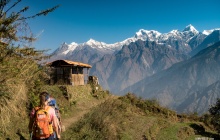 From Khorla Besi, we trek along the Budhi Gandaki River for several days. We go through the hot springs of Tatopani and reach the first gorges. We settle down in a local lodge in Sirdibas,
From Khorla Besi, we trek along the Budhi Gandaki River for several days. We go through the hot springs of Tatopani and reach the first gorges. We settle down in a local lodge in Sirdibas,
Hiking: 6 hours
Elevation: + 450m
Accommodation: Lodge -
Day 6 Sirdibas - Dyang (1860m)
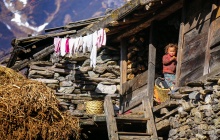 This area is mainly inhabited by Gurungs and Tibetans. With the increasing altitude, tropical vegetation gradually gives way to a more alpine atmosphere. We walk between dense woodlands and rocky outcrops to Dyang.
This area is mainly inhabited by Gurungs and Tibetans. With the increasing altitude, tropical vegetation gradually gives way to a more alpine atmosphere. We walk between dense woodlands and rocky outcrops to Dyang.
Hiking: 5 to 6 hours
Elevation: + 440m
Accommodation: Lodge -
Day 7 Dyang - Namrung (2540m)
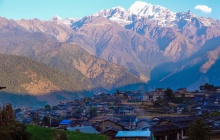 We walk through the gorges to Ghap village. A Tibetan ambiance greats us; manis walls and chortens decorate the entrances and exits of the villages. Prayer flags flutter from stone houses with slate roofs and it is clear from the local dress and traditions that we are approaching Tibet
We walk through the gorges to Ghap village. A Tibetan ambiance greats us; manis walls and chortens decorate the entrances and exits of the villages. Prayer flags flutter from stone houses with slate roofs and it is clear from the local dress and traditions that we are approaching Tibet
Hiking: 6 to 7 hours
Elevation: + 680m / -60m
Accommodation: Lodge -
Day 8 Namrung - Syala (3330m) - Samagaon (3390m)
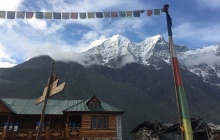 Our trek crosses many Tibetan villages. As we arrive in Lho, we are greeted by our first views of the summit of Manaslu culminating at 8163 m. We continue to Samagaon, a Tibetan village at the foot of the Manaslu mountain range.
Our trek crosses many Tibetan villages. As we arrive in Lho, we are greeted by our first views of the summit of Manaslu culminating at 8163 m. We continue to Samagaon, a Tibetan village at the foot of the Manaslu mountain range.
Hiking: 7 hours
Elevation: + 870m / -150m
Accommodation: Lodge -
Day 9 Manaslu Base Camp (4400m) - Samagaon
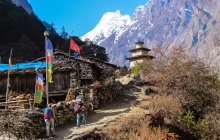 A day of acclimatization in preparation for the ascent to Larkya La pass (5100 m) which we will cross in 3 days time. We walk to Lake Birendra (3 hours round trip), fed by the glacier of Manaslu. Conditions depending we can then continue to the base camp of Manaslu (optional - 3 more hours of walking). The first part of this climb follows a wooded path, but very quickly we find ourselves immersed in the mineral high mountain atmosphere. Discover an unobstructed view of the impressive glaciers of Manaslu. Return along the same route to Samagaon.
A day of acclimatization in preparation for the ascent to Larkya La pass (5100 m) which we will cross in 3 days time. We walk to Lake Birendra (3 hours round trip), fed by the glacier of Manaslu. Conditions depending we can then continue to the base camp of Manaslu (optional - 3 more hours of walking). The first part of this climb follows a wooded path, but very quickly we find ourselves immersed in the mineral high mountain atmosphere. Discover an unobstructed view of the impressive glaciers of Manaslu. Return along the same route to Samagaon.
Hiking: 3 to 6 hours
Elevation: + 1200m / -1200m
Accommodation: Lodge -
Day 10 Samagaon - Pung Gyen Monastery (3870m) - Samdo (3690m)
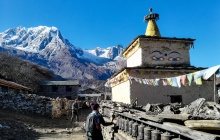 Morning departure to Pung Gyen Monastery. Found at 3870 m this magical place is just a few steps from gigantic glaciers. The monastery was built in a large meadow at the foot of the majestic Manaslu massif. Our morning effort is largely rewarded by breathtaking 360 ° views of the surrounding high peaks and Manaslu summit. We descend to Sama Gaon, then continue to Samdo, the last inhabited village before the collar of Larkya La.
Morning departure to Pung Gyen Monastery. Found at 3870 m this magical place is just a few steps from gigantic glaciers. The monastery was built in a large meadow at the foot of the majestic Manaslu massif. Our morning effort is largely rewarded by breathtaking 360 ° views of the surrounding high peaks and Manaslu summit. We descend to Sama Gaon, then continue to Samdo, the last inhabited village before the collar of Larkya La.
Hiking: 5 hours
Elevation: + 920m / -550m
Accommodation: Lodge. -
Day 11 Samdo - Dharmasala (High Camp - 4335m)
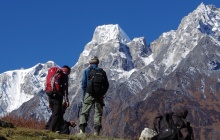 Samdo is only a few kilometers from Tibet; here an improvised market is organized between Tibet and the locals. We climb up the glacier valley to reach the foot of the Larkya glacier.
Samdo is only a few kilometers from Tibet; here an improvised market is organized between Tibet and the locals. We climb up the glacier valley to reach the foot of the Larkya glacier.
Hiking: 4 hours
Elevation: + 550m
Accommodation: Lodge -
Day 12 Col of Larkya (5100m) - Bhimtang (3600m)
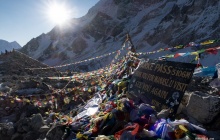 Today we reach the highest point of our trek, the Larkya pass (5100 m). It is a long steady climb upwards and the show is grand. The long descent presents sublime views of the circus of Peri Himal. Overnight in the paradisaical Bhimthang.
Today we reach the highest point of our trek, the Larkya pass (5100 m). It is a long steady climb upwards and the show is grand. The long descent presents sublime views of the circus of Peri Himal. Overnight in the paradisaical Bhimthang.
Hiking: 8 to 9 hours
Elevation: + 750m / -1500m
Accommodation: Lodge -
Day 13 Bhimtang - Dharapani (2000m)
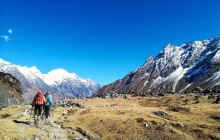 We descend quietly along a pastoral trail of woodland, rhododendrons and conifers to Tileche village where Tibetan Manangis live. Then, we continue to Dharapani, where we join the beginning of the Annapurna Circuit.
We descend quietly along a pastoral trail of woodland, rhododendrons and conifers to Tileche village where Tibetan Manangis live. Then, we continue to Dharapani, where we join the beginning of the Annapurna Circuit.
Hiking: 7 to 8 hours
Elevation: -1300m
Accommodation: Lodge -
Day 14 Dharapani - Besisahar - Kathmandu
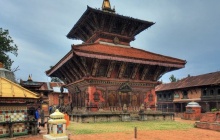 This morning, we take local transport to Besisahar and then continue on to Kathmandu.
This morning, we take local transport to Besisahar and then continue on to Kathmandu.
Accommodation: Hotel
Transport: 7 hours drive
Meals not included -
Day 15 End of stay
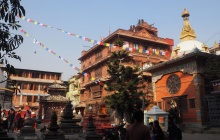 End of our services
End of our services
Dates & prices
International departures:
No departure for now
Trip code: NEPMAN-EN
Included
- All in-country transfers by private vehicle as detailed in itinerary
- Accommodation in 3 * hotel or B&B in Kathmandu (Hotel Tibet, Manaslu or similar)
- Trek includes full-board and lodging
- Full accompaniment by an English speaking Altaï Guide
- Visits as per itinerary: with a cultural guide in a private vehicle
- Luggage transport - up to 12kg maximum per person during the trek
- Trekking support team: assistants and porters
- Trekking permits: the Manaslu region, ACAP and TIMS
- Staff Insurance
- All local taxes
Not included
- Entrance to historical sites & monuments
- Meals in Kathmandu - Lunch Day 1 & Dinner Day 13
- Nepalese visa: US $ 25
- International flights
- Insurance: Repatriation, Medical & Helicopter Services
- Drinks, tips and personal expenses - all that is not in "THE PRICE INCLUDES"
Notes
Level 4/5
Terms and conditions
Booking conditions
Invoice procedure
Cancellation policy
- Cancellation received more than 30 days prior to the departure date: a sum of €50 per person will be retained
- Cancellation received 30 to 21 days before the departure date: your deposit, 30% of the total trip price will be retained
- Cancellation received 20 to 14 days before the departure date: 50% of the total trip price will be retained
- Cancellation received 13 to 7 days before the departure date: 75% of the total trip price will be retained
- Cancellation received less than 7 days before the departure date: 100% of the total trip price will be retained
- Fixed airfares: if your airline ticket was issued in advance, often done to avoid significant surcharges, you will be charged 100% of any non-refundable fees if you wish to change or cancel your flight plan.
- Fixed in-country costs: early charges for firm bookings will be charged if you cancel or modify your trip.
- Insurance costs: if you have taken out comprehensive or cancellation insurance, the cost of insurance is due and cannot be refunded.
Changes to travel contract
Pricing
Contract transfer
Insurance
Practical info
Staff
Food
Accommodation
Transportation
Budget & exchange
Tips
Vital equipment
- Warm Sleeping Bag
- Water purifiers (micropur, aguatabs ...)
- A cap or sunhat
- 1 or 2 sets of thermals: long-sleeved thermal tops and full-length long johns
- Long sleeved and short sleeved t-shirts, preferably in quick-drying technical material
- A light fleece or equivilent (plus extra warm layers if necessary)
- A breathable wind proof, waterproof jacket (Gore-Tex...)
- Lightweight waterproof over trousers
- Suitable shorts
- Walking trousers
- A pair of high-rise walking boots - strength, good grip of the foot and ankle (high stems) and impermeability are essential. Choose shoes with non-slip soles (vibram).
- A pair of trainers/sandels or equivilent casual shoes for cities, villages and evenings
- Thick walking socks
- Warm gloves, hat and scarf (it can be chilly in the mountains)
Material
- No cotton
- Always carry dry spares of everything, including underwear and gloves
- A warm breathable base layer
- A second thermal layer
- Wind and water proof protective outer layers
Luggage
- A rucksack (35-40L or 45-50L) for use as a day bag. This will contain your (vital) personal belongings for the day (sweater, spare t-shirt, water bottle, picnic-lunch, sunglasses, small things ... )
- We use porters to transport our other belongings when trekking. Please bring a flexible travel bag with zips for easy access max 80L and max 13kg (16kg with camping gear). Please do not bring suitcases or other hard bags which the porters cannot transport.
- You may also be able to store some belongings securely at the hotel in Kathmandu.

